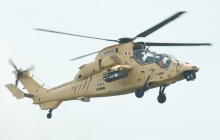
On 3rd June, at the Landes test center, the DGA (French procurement agency) performed a guided rocket qualification fire from an Airbus Tigre HAD attack helicopter flying at 70 knots on a target illuminated by a ground operator. This fire is part of a series of tests that began in 2010. The last one was conducted in January 2014 from a Tiger HAP. This fire will be followed by others, including tests of the guided rocket on a moving target.
The interest of having such a guided rocket is to implement a highly accurate ammunition for a limited cost, as it is indeed much cheaper than a missile (at least twice cheaper). The last French operations in Afghanistan, Libya and Mali have confirmed the relevance of this capability: The first version of the Tiger (HAP Appui Protection) lacks precision ammunitions. That is why the ageing Gazelle helicopters, very vulnerable, equipped with missile HOT are still engaged in operations. The rockets pods (unguided) of the Tiger HAP (the only version deployed in operations) are only used in zone firing. The crew has only the 30 mm gun to make precision shots, but must engaged the target within 1500 meters, thus exposing the helicopter to the enemy fire. Tomorrow, the most complete version of the Tiger, the HAD (Appui Destruction), which should see its first deployment in October in Sahel, will implement the Hellfire missile (8 km range against 7 km for a rocket). Very accurate but very expensive. “We will not fire as many Hellfire missiles tomorrow that we fire HOT missiles today” said an officer from the French Army light aviation. The interest lies here: avoiding to fire a much more expensive weapon than their targets (pick-up or infrastructure) while avoiding collateral damage.
The development of the capability of a laser guided rocket is part of a wider Upstream Study Plan (PEA) launched by the DGA in 2009 to develop common technologies to various ammunitions. These studies concern the guided rocket fired from a helicopter, but also artillery 155 mm, 120 mm shells fired from a Leclerc MBT or mortar 120 mm shells. These technologies include a guidance kit, a laser sensor, a computer or a control system actuators. The metric precision rocket remains today the most advanced programme among the PEA MPM guided ammunitions "for the 120 mm mortar, it will be at the same level in two years than the guided rocket today " said a programme manager.
Discussions are underway to integrate this new capability in the MK2 standard of the Tiger attack helicopter. This standard is expected to enter in service by 2018/2020, and besides processing of obsolescence, the integration of SIT ALT (command and communication system), the rocket pod will include guided ammunitions. Few adaptations are necessary: the pod remains the same. The target will be illuminated by laser, either by a ground operator or by the helicopter itself. The Tiger HAD will then have a full range of armaments: 30 mm gun, air-to-air Mistral missiles, Hellfire for heavily armoured targets and rockets (guided or not) for various targets.
TDA (a subsidiary of Thales), the rocket manufacturer, will soon be able to offer this new guided ammunition for export. So far, only France and Spain Tiger helicopters implement the TDA rockets. But the industry is confident for the future and discussions are reportedly underway. The guided rocket offer is limited, besides France, only the United States and Turkey have developed similar solutions.

 212
212
 6
6

 77
77
 1
1

 64
64
 2
2